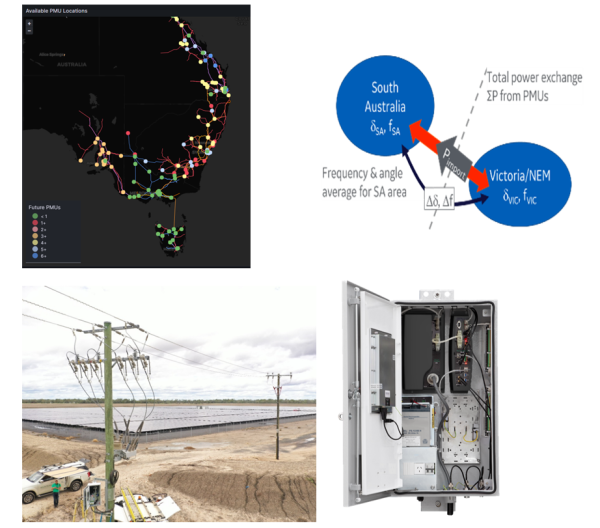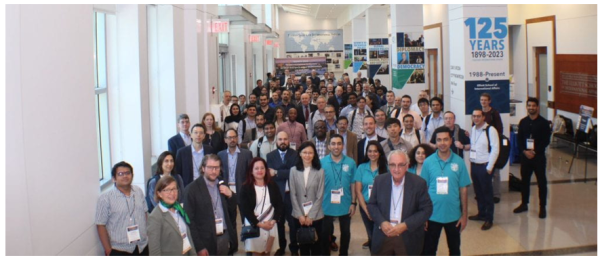Cigre Australia
empowering
networking
global know-how
Feedback from a leading CIGRE / IEEE forum on the use and benefits of synchrophasors for smart grids
Synchronised phasors (synchrophasors) provide time synchronised real-time measurement of electrical quantities from across the power system. They are increasingly being used in many applications, particularly for situational awareness and control to keep the power system stable and functional in challenging circumstances.
Four Australian representatives attended and presented at a panel session during the 2024 International Conference on Smart Grid Synchronized Measurements & Analytics (SGSMA) from 20-23 May. The representatives were James Guest, Devinda Parera, Filip Ivanovski and David Dart.
The conference is a leading forum for this topic and brings together leading researchers and developers from academia, research, and industry across the world to facilitate innovation, knowledge transfer, and technical progress in addressing synchronized measurements and analytics to advance smart grids. It incorporated paper sessions, tutorials, exhibitions, and panel sessions.
CIGRE Australia representatives were invited to participate at the SGSMA conference panel session by the SGSMA Association Board chair after he attended the B5 Study Committee Synchrophasor Tutorial at the CIGRE 2023 Cairns Symposium.

The Australian panel session was titled ‘Applying synchrophasor technology for protection and control of the Australian power system’. It included three 20 minute presentations followed by 30 minutes of questions and answers. The panel was chaired by CIGRE B5 Study Committee Chairperson Rannveig S. J. Løken. The presentations covered the following applications:
- ‘AEMO’s Wide Area Monitoring System (WAMS) Synchrophasor Project & Associated Standard Data Guidelines’ by James Guest (AEMO)
- ‘South Australia Wide Area Protection Scheme (WAPS) Synchrophasor Application associated with increased renewables and interstate connection’ by Devinda Perera (ElectraNet) & Filip Ivanovski (CSE Uniserve)
- ‘Applications of Synchrophasors to distribution networks - An Evaluation of a grid scale data acquisition trial’ by David Dart (NojaPower).
The Australian panel session attracted an almost full room of attendees. Following the presentations there was a wide range of audience questions covering all the presentation topics. Feedback indicated that the audience found the technical detail and range of topics interesting and informative. Panel presentations for this and the other 9 panel sessions can be downloaded at https://blogs.gwu.edu/seas-sgsma2024/sgsma-2024-panel-presentations/

During the conference there were opportunities for the Australian representatives to attend paper presentations, other panel sessions, tutorials and discussions. Below are some their highlights and feedback.
- There were discussions about the cost benefits of Synchrophasors and Synchronised sampled value measurements. A cost benefit analysis report called,” distribution_synch_measurement_roadmap_20210927” was referenced during the conference - https://www.naspi.org/node/934 .
- Synchro-Waveforms (or synchronised sample values) are starting to be utilised more within the distribution network. The benefits are the significantly higher frequency response than PMU data. For example, oscillations can be better characterised, and the source of harmonics can be detected. Disadvantages are significant higher comms infrastructure and cost.
- High frequency oscillations due to inverter based generators as well as loads (such as Data Centres) is an emerging issue and there is increased focus on Synchro-Waveforms to monitor these events.
- Synchrophasor based Wide Area Protection and Control Schemes are evolving.
- A major revision (Version 3) of the C37.118.2 standard is to be released soon. This standard defines message types, data types, contents, format and use.
- Online monitoring applications that are emerging and have strong potential to grow include, inertia monitoring, linear state estimated, oscillation monitoring and source location and, voltage stability.
- Focus on technologies/methods for accurate prediction and classification of events – power utilities still rely heavily on signal processing as well as statistical and power system models, whereas research/academia use AI/ML techniques.
- Some concerns over jamming and spoofing time synchronisation signals from an external reference. Clock vendors are being designed with more resilient GNSS (Global Navigation Satellite System) receivers or promoting use of terrestrial time transport already being used by the telecom industry see https://netinsight.net/5g-sync/
- IEEE 2664 Streaming Telemetry Transport Protocol (STTP) is undergoing standardisation. This protocol is optimised for time series data, including continuous POW (Point on Wave) which demands transport of high-volume data, see https://sttp.info
If further information is required, please contact the Australian representatives to discuss. Many thanks to James, Devinda, Filip and David for sharing their conference experience.

